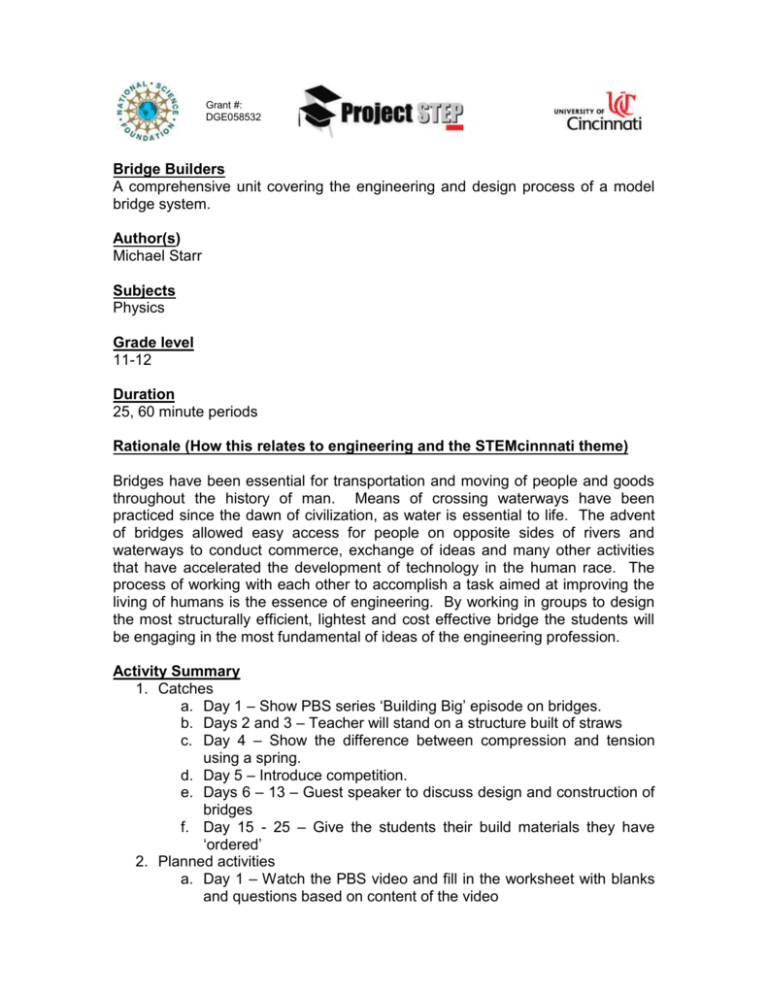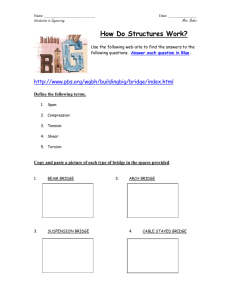Lesson Plan
advertisement

Grant #: DGE058532 Bridge Builders A comprehensive unit covering the engineering and design process of a model bridge system. Author(s) Michael Starr Subjects Physics Grade level 11-12 Duration 25, 60 minute periods Rationale (How this relates to engineering and the STEMcinnnati theme) Bridges have been essential for transportation and moving of people and goods throughout the history of man. Means of crossing waterways have been practiced since the dawn of civilization, as water is essential to life. The advent of bridges allowed easy access for people on opposite sides of rivers and waterways to conduct commerce, exchange of ideas and many other activities that have accelerated the development of technology in the human race. The process of working with each other to accomplish a task aimed at improving the living of humans is the essence of engineering. By working in groups to design the most structurally efficient, lightest and cost effective bridge the students will be engaging in the most fundamental of ideas of the engineering profession. Activity Summary 1. Catches a. Day 1 – Show PBS series ‘Building Big’ episode on bridges. b. Days 2 and 3 – Teacher will stand on a structure built of straws c. Day 4 – Show the difference between compression and tension using a spring. d. Day 5 – Introduce competition. e. Days 6 – 13 – Guest speaker to discuss design and construction of bridges f. Day 15 - 25 – Give the students their build materials they have ‘ordered’ 2. Planned activities a. Day 1 – Watch the PBS video and fill in the worksheet with blanks and questions based on content of the video b. Day 2 and 3 – Student individual activity will be to build a wireframe cube using toothpicks cut to specified dimensions and measure how much load it can take using something like nuts as the load (counting how many each structure holds). Next they will build a structure with two cross beams (trusses) for added support and test the strength again. Finally they will compete in a competition where they build their own structure and see who has the lightest structure that holds the most weight (I would expect the students to max out the amount of load that can be applied, the tiebreaker is lightest structure, i.e. least amount of material). They will also be completing the pre-test at this point which will have questions about which members they think are in tension or compression for a particular situation as well as advanced questions about structures which they should not be able to answer at this time (all the way up to calculating the load in each member of a simple truss or triangle system). c. Day 4 – Present students with the letter for the bridge competition. Discuss different truss styles and what it means to be in compression and tension. Use the simple truss example where one structure the diagonal trusses go 90 degrees to the other example and explain why in one situation the cross-members are in tension and the other they are in compression. Explain why the members in tension is the better scenario. d. Day 5 – Students will be filling out a worksheet with the competition rules on it with blanks at key points. Students will complete this individually and fill in the blanks as the instructor or different students take turns reading the rules to the class. If students are reading the rules the instructor must help them fill in the blanks when they come to them in the course of reading. Conduct a question and answer session for the students on the bridge competition rules so students are clear on the rules. Additional rules for the lesson will include keeping a group engineering notebook complete with technical notes, design and development ideas as well as calculations for cost analysis of their materials (i.e. balsa wood, doll rods and adhesive of their choice). e. Days 6 – 13 – Try to get a structural engineering professor to come in from a local university to discuss different types of structural ideas and design ideas for bridges with the students. Also a good opportunity for discussing opportunities for choosing engineering as a profession. Students will conduct guided planning in groups of 3 where they design their bridges using the help of instructors and software, which they will be introduced to after the discussion from the engineering professor. f. Day 14 – Students will be presenting their design to the class along with the amount of materials they are requiring and a cost analysis based on the values applied to each of the build materials. g. Day 15 – 25 – Students will build their bridges to the designs they have come up with. Activity Day 1 Catch and Activity – Video with questions to answer Days 2 & 3 Catch – Teacher stand on structure built of straws Activity and Pre-test – Students will build the structures of a wireframe cube and a trussed cube and answer questions at the end Building – Students will build their own structure out of straws and compete against each other Testing their structures Day 4 Catch – Present students with the letter for the Bridge competition so they will be introduced to the competition at this point. Pre-test: Diagonals in tension or compression Tension verses compression activity using straws – Includes worksheet Discussion of the differences between tension and compression using examples Post-test: Same question on diagonals Day 5 Catch – Pass out the rules for the competition Read the rules with blanked out key items with the class having students fill in the blanks as they go. Question and Answer session on competition rules Discussion of cost analysis portion and engineering notebook requirements Assemble students into groups of 3 and have them work on the computer to build trusses in the computer program and apply loads recording answers to questions Days 6 -13 Catch – Dr. Miller in to talk about bridge design and design theory Planning – Students will begin planning their bridges in their groups, recording Time 60 minutes 2 minutes 40 minutes 40 minutes 38 minutes 5 minutes 5 minutes 15 minutes 30 minutes 5 minutes 1 minute 15 minutes 10 minutes 10 minutes 24 minutes 60 minutes 420 minutes their engineering journals and performing cost analysis calculations Day 14 Student groups will present their design ideas to the class along with their cost analysis and an engineering report Day 15 – 24 Catch – Students will be given their build materials Building – Student groups will assemble their bridges Post test – Will be asked the same questions from the activity they performed on days 2 and 3 Day 25 Competition Day! 60 minutes 5 minutes 525 minutes 10 minutes Depends on the competition organizers Objectives Upon completion of this lesson, students will be able to: 1. Identify members of a truss system as being in compression or tension and it is possible for some members to experience no load. 2. Use trial and error for improving the design of a supportive structure using both physical and computer models. 3. Work as a group on an engineering project and complete a bridge structure from design conception to completion for testing. Standards Ohio Standard: Mathematics Geometry and Spatial Sense: 11-12 Benchmark A: Use trigonometric relationships to verify and determine solutions in problem situations. Mathematical Process: 11-12 Benchmark I: Communicate mathematical ideas orally and in writing with a clear purpose and appropriate for a specific audience. Ohio Standard: Science Physical Sciences: 11-12 Benchmark D: Apply principles of forces and motion to mathematically analyze, describe and predict the net effects on objects or systems. Scientific Inquiry: 11-12 Benchmark A: Make appropriate choices when designing and participating in scientific investigations by using cognitive and manipulative skills when collecting data and formulating conclusions from the data Background knowledge Students will have been introduced to the concept of forces involved in motion situations as well as static situations. They will be familiar with vector representation of forces. They will have been exposed to the concepts of tension and compression. Materials Required Worksheets for the various activities Toothpicks Masking tape Scissors 3x5 index cards Plastic cups Graduated cylinders Water Drafting Kit – including T-square, 12” architectural scale, 45-45-90 Triangle, 30-60-90 Triangle, Exacto Knife, 6” protractor, erasing shield, 6” compass, 6” divider, mini lead pointer, French curve 0.7 mm mechanical drafting pencil Balsa wood ¼” x ¼” cross section Poplar wood ¼” x ¼” cross section Poplar ¼” diameter dowel rods Poplar 1/16” diameter dowel rods Balsa wood strips Glue (super glue, gorilla glue, epoxy, etc… whatever the students think about using) Matchbox car Activities Present the stimulus material (activity): Day 1: Hand out the work sheet on the video to be shown. Show the students the ‘Building Big: Bridges’ video from the PBS series. As they watch they will fill out the answers to the questions on the worksheet. Hand in the completed work sheet for grading. Days 2-3: Students will be given straws and masking tape along with a worksheet with two drawings on it. They are to construct the first drawing as seen below using the masking tape and toothpicks, cut to the dimensions as illustrated on the worksheet. Students will then place a 3x5 note card on top of their structure and a plastic cup on the card. This must be done near a sink and not at their desks as it will get very wet. They will fill a graduated cylinder with water and begin slowly pouring water in the cup, keeping track using the graduated cylinder, how much they have poured. Once their structure falls over they are to record the amount of water their structure held. Next they will make a new structure using their straws with cross members on opposite sides of the structure going in the same direction and repeat the loading experiment. The structure should look like the following: After loading they should see that the amount of load increased because of the added stability of the truss system. Next they will be charged with maximizing the load capacity by designing their own cube structure capable of carrying the most weight. This will be a competition type thing and the student that makes the lightest structure that carries the most weight will receive a candy bar or something… This whole activity should take only two days. They will have the competition during the second half of the second day. After this activity they will be given the pre-test. This happens before the only discussion they have heard concerning different bridge structures and loading has been in the video they watched. The instructor has not yet talked about truss systems and how loads are distributed. Day 4: Present the letter to the students for the bridge competition. Discuss the truss style to reinforce the idea of compression and tension in truss systems. Show the example of the truss diagonals where one is in compression and the other is in tension and get them to infer that the member in tension is better than the member in compression. Perhaps an activity is in order here. One where they test the strength of a straw in compression verses its strength in tension (this part is up to the instructor). A simple hand pressure experiment will show them that in compression the member tend to buckle whereas in tension it takes a lot more stress to do anything. Ask them how they could improve the members in compression. See the figure for what to do on this. Use these figures to show how load in truss systems is distributed either in compression or tension and further discuss how tension and compression can change as the load moves along the bridge. Load Diagonals are in compression Load Diagonals are in tension So now the students will have an idea of where to start with truss systems. Next discuss the necessity of a fixed node to one end and a horizontal or vertical rolling node on the other to allow for flexing of the structure and even distribution of force throughout the fixture by allowing it to flex. Ask if they know how this will be achieved in the competition (i.e. neither end will be fixed and can flex horizontally if need be). Day 5 Present the competition rules with blanked out words to the students and read through it with them having them fill in the blanks as they read it. Discuss the rules in more detail clarifying points of confusion and having an answer question session with the students regarding the rules. Discuss the additional aspects required for the physics class involving an engineering notebook complete with technical notes, design and development journal, structural analysis, and cost analysis. Explain how much the balsa wood will cost and other types of wood that can be used and strategies such as laminating and types of glue used (pass out the handout with material costs). Assign cost values to each item, types of wood, types of glue, etc. Have computers on this day and show them the link to the truss designing software. Take the rest of the day and probably into the next on how to use the software to design 5 examples of truss systems as covered in the discussion from the previous day (see the handout). Then have them apply 50 N load to the middle of the bottom part of the structure and see what happens. Answer questions about members in tension and in compression and figure out how they could improve the design. Could throw some examples in where members experience no load and have them realize that they could cheapen the cost of the bridge and lighten it by removing that member without compromising the structure. This will probably spill into day 6 where you will let them play with the software on their own and start designing their own bridges and testing them in the software environment. Days 6-13: Try to get a structural engineering professor to come in from a local university to discuss different types of structural ideas and design ideas for bridges with the students. Also a good opportunity for discussing opportunities for choosing engineering as a profession. Students will conduct guided planning in groups of 3 where they design their bridges using the help of instructors and software, which they will be introduced to after the discussion from the engineering professor. Day 14 Students present their designs to the class in terms of what type of materials they are using, type of structure and how they are going to put it all together. Will also present why they have chosen the design they have chosen based on their own research in the classroom. Their presentations should include some drawings and a cost analysis sheet that they hand in to the teacher. Days 15 – 25: Start the build process. Students will be given their needed amount of materials and begin to build and keep a log of the building process. What appears to be working and what is causing trouble? Will also have to keep track of actual amount of material used i.e. if cut some away and do not use the cut piece have to count it as an additional cost. Also screw-ups will be counted so they can see how close they are to their initial budget proposal. Build all the way to the competition then hand in their engineering notebooks and journals for evaluation. Place high at the competition! Eliciting the desired behavior/review: Performing the activities should provide an understanding in students as to how triangles can be used to measure the size of objects. Assessment of Student Learning Assessment will be based on scores on pre-assessment as compared to post assessment Assessment of the Activity Distribution of the STEP activity assessment form to the students and to the teacher.





